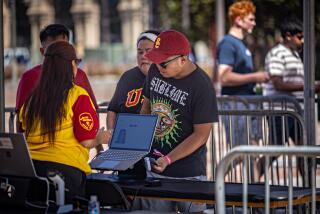At CSUN, Tradition Is the Annual Search for One : Graduation: After repeatedly failing to find a massive ceremony that isn’t a nightmare, administrators have a downsized formula.
- Share via
Graduation at Cal State Northridge was beginning to resemble a Rolling Stones concert, without the rock ‘n’ roll.
There were traffic snarls, packed crowds and occasional drunken shouting.
Beleaguered administrators tried to calm the chaos with an early-morning ceremony. They moved off-campus, then came back. They banned alcohol. They even asked for suggestions from students.
This year--in the continuing quest to find a new tradition for the most traditional of collegiate events--CSUN has resorted to a battle strategy known as “divide and conquer.” Administrators hope that by dividing graduation into eight smaller ceremonies, they can conquer commencement congestion.
“Pomp and Circumstance” will literally echo across Northridge as the separate graduations--one for each academic school--are staged over the course of five days beginning May 24.
The change will break up a mass of 6,700 seniors plus their families that is too large to assemble in one spot. “It’s about time,” said Kurt Silberstein, 29, a business senior. “Graduation was a zoo the other way.”
CSUN’s commencement problems began in the early 1980s when graduating classes increased to unwieldy sizes.
This year’s class, for example, is a third larger than the class of 1990. In 1985, the administration scheduled a morning ceremony and prohibited alcohol in hopes of subduing unruly students. A year earlier, graduation had been disrupted by shouted obscenities. In 1989, construction on campus forced CSUN to move commencement to the Hollywood Bowl, which upset many students.
Even more upsetting was the three-hour traffic snarl that clogged roads into the amphitheater.
Graduation was delayed by more than an hour as traffic officers cleared a path for university President James W. Cleary.
“My friend graduated at the Hollywood Bowl and said it was a disaster. He said people were actually getting out of their cars and running along the freeway in their caps and gowns,” said Shawn Kaminkow, 22, a political science senior who supports the switch from big to small. “If it was going to be the big graduation, I wasn’t going to go. I was fighting with my parents about it.”
Last year, the ceremony returned to campus and drew 27,000 students and family members, a contingent that filled surrounding streets with pedestrians and cars.
“As with any Southern California event, people worry about traffic and where they are going to park,” said Heidi Nickerson Levy, the commencement program planner.
Levy surveyed 1990 graduates and asked for suggestions. A majority voted for smaller gatherings.
They wanted their parents to be close enough to see them on stage. They wanted their names announced, a formality that could not be included en masse .
Some students and staff are sad to lose the grandeur of a school-wide ceremony. But it appears that far more are excited by the prospect of a more intimate gathering.
Some of the commencements will be especially small. The School of Education has only 320 graduates and the School of the Arts has 400.
“It was so impersonal before. All the crowds and hassles,” said Kris Shelton, 24, who will receive an anthropology degree. “So negative.”
More to Read
Sign up for Essential California
The most important California stories and recommendations in your inbox every morning.
You may occasionally receive promotional content from the Los Angeles Times.











